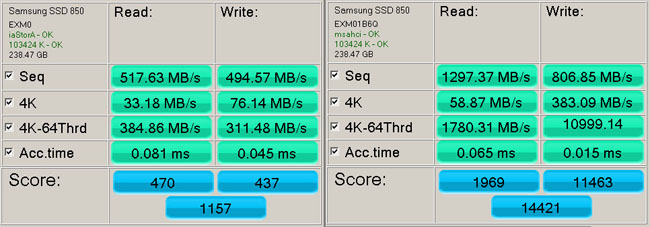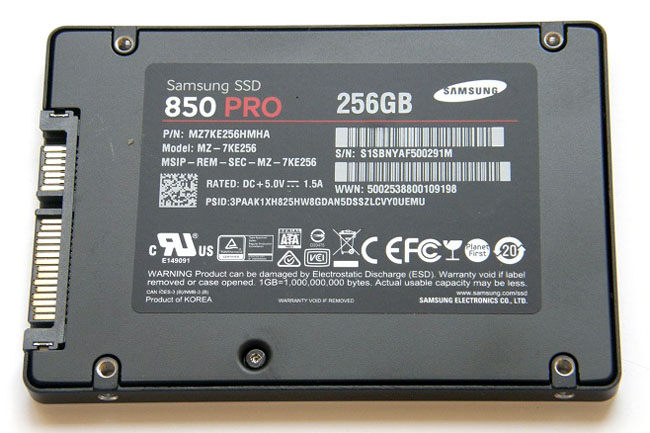
Samsung SSD850 PRO 3D V-NAND storage
Samsung has some clout, that's for sure and with the latest consumer drive range, the SSD850 PRO, it has another first: the world’s first consumer drive to use 3D V-NAND, in this case the 32-layer version of the technology.
Lest we forget just how fast NAND memory cell structure has developed: in just 15 years it has gone from a 120nm process down to a 16nm process. At the same time, capacity has grown a hundred fold.
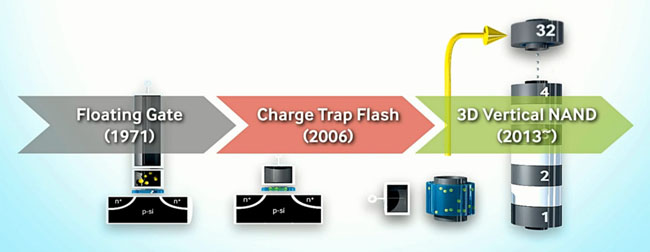
SSD storage NAND development timeline
That said, the standard 2D Planar NAND technology is fast approaching the buffers, as far as die shrinkage is concerned. This is why most of the major players in the NAND game have designs in one form or another for the next major leap in NAND development – 3D NAND.
It comes as no real surprise to find that Samsung is the first to market drives using the new NAND. Its take on the idea is what the company calls 3D V-NAND, or to give it its correct title, 3D Vertical NAND. The clue of why this NAND is so special is in the name.
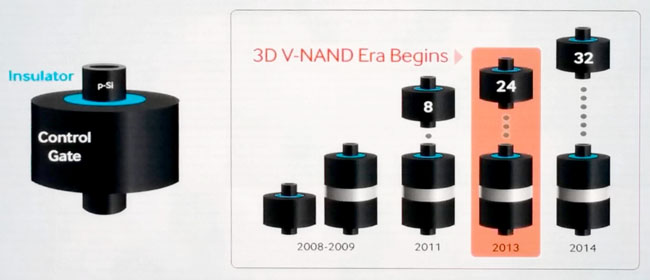
3D V-NAND layering timeline
3D V-NAND has the flash cells stacked on top of each other and alongside each other, hence the three dimensions reference. The vertical stacking being the most significant factor that is able to offer 100 times the capacity of standard 2D Planar NAND in only 1/10th of the same area. It's this type of technology that opens the doors for the only real remaining holy grail of SSDs; much larger capacity drives.
The new technology negates the constraints that manufacturers of standard NAND come up against as they constantly try to shrink 2D Planar NAND down to ever smaller die sizes to get ever denser cells, in particular cell-to-cell interference and patterning.
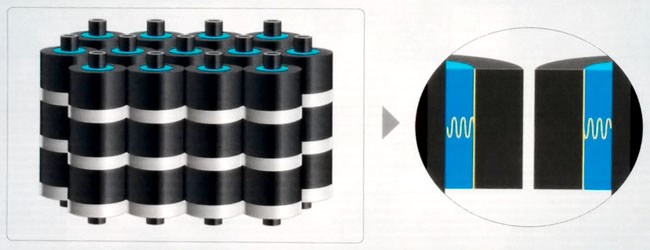
Cell-to-cell interference-free structure
Cell-to-cell interference occurs when an electric charge flows into one cell, causing a similar charge to flow into a neighbouring cell (the coupling effect). When this happens the data in the neighbouring cell gets corrupted. This interference isn’t a problem when the space between cells is greater than 30nm but as dies shrink smaller and smaller, so the risk of interference grows.
The problem with patterning is that it is limited within the 10nm process but it’s a vital technology for 2D Planar NAND, as it allows for greater density through the photolithography process.
RAPID developments
Samsung's 3D V-NAND eliminates both these problem areas because of the vertical arrangement of the cells. It has a wider bit line and a 40nm process, both of which remove the problem of cell-to-cell interference and because the vertical layers are stacked in three dimensions to increase density, there is no need to use the photolithography process to increase capacity.
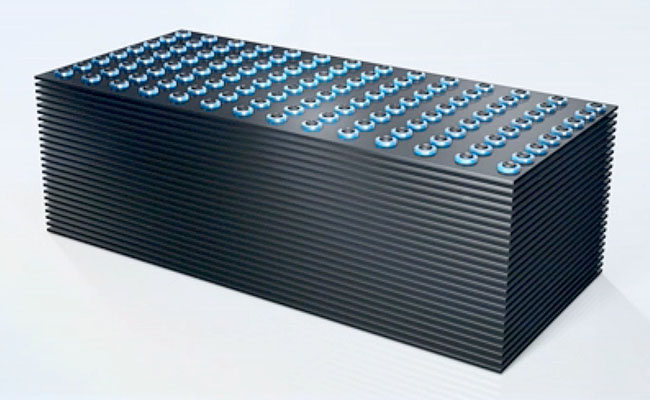
3D V-NAND layers
Also the new technology replaces the conductor of 2D Planar NAND with an insulator which enables the cells to hold their charge after the data is written to them. At the time of writing, Samsung has two versions of 3D V-NAND: 32-layer in the SSD850 Pro and 24-layer in the SSD845DC Pro reviewed recently, which is aimed at the data centre/enterprise segment.
According to Samsung 3D V-NAND is a win-win technology bringing with it more capacity, better performance, much better NAND endurance and more efficient use of power. The keys here are capacity and endurance. The technology should allow for some seriously big drives, around the 6 - 8TB mark to see the light of day in the not too distant future, with some serious endurance figures to match.
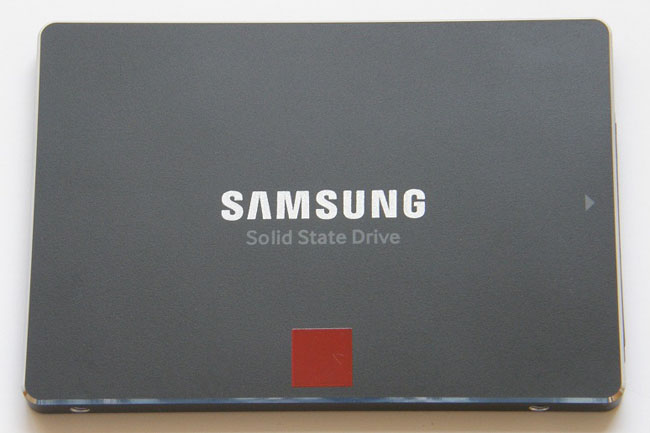
Samsung SSD850 PRO – the latest in a new range of consumer SSDs
Samsung’s new range is made up of four capacities 128GB, 256GB, 512GB and the flagship 1TB model. The 128GB version comes with 256MB of LPDDR2 cache, the 256GB has 512MB with both the 512GB and the 1TB having a 1GB cache.
The new drives use the same three-core ARM Cortex eight channel controller – the R4, clocked at 400MHz that was launched in the SSD840 EVO – but with a new version of firmware to control the new NAND. The firmware brings AES 256-bit, TCG Opal 2.0/eDrive and DevSleep support.
Samsung quotes Sequential Read/Write performance for the 256GB version of the SSD850 at 550MB/s. This turns out to be the same figure for all for drives in the range, while the write speed is quoted as 520MB/s, the same as for both the 512GB and 1TB models. The 128GB version comes in at 470MB/s writes.
Tested with the ATTO benchmark, the review sample 256GB drive surpassed both of those figures, producing a read score of 564MB/s and 536MB/s for writes. The 4K write speed in CrystalDiskMark is particularly impressive at 145MB/s but even better is it’s high queue-depth performance in both CrystalDiskMark (409.7MB/s reads, 369.8MB/s writes) and AS SSD (384.86MB/s reads, 311.48MB/s writes).
Doing a little bit of real life testing, the drive took just over nine minutes to copy a 50GB folder containing 28,523 files; just over two minutes to copy a 17GB Blu-Ray image; and a mere 30s to copy a 4GB photo.
The SSD850 PRO has the latest version of Samsung’s RAPID (Real-time Accelerated Processing Of I/O Data) software technology bundled with it, accessed via Samsung’s Magician app. Version 2 of RAPID can use a maximum of 25 per cent of a system’s memory (for instance, 2GB in an 8GB memory equipped system) which is a significant leap up from the 1GB maximum capacity of the original version of the technology.
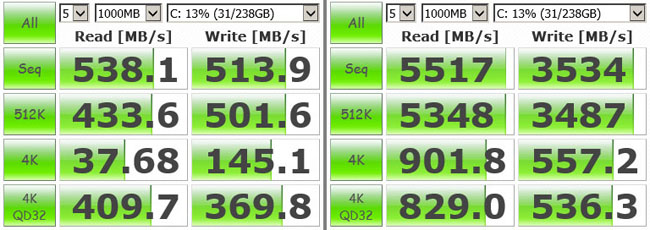
CrystalDiskMark results – normal (left), RAPID mode (right)
Basically, RAPID uses some of the system memory to cache frequently accessed applications, in effect a RAM cache drive. The boosts in performance are, to say the least astonishing.
Remember those ATTO scores? Well, with RAPID enabled the read performance rockets from 564MB/s to 3892MB/s, yes that’s right 3.8GB/s, while the writes reach a mind blowing 2836MB/s – or, if you like, 2.8GB/s. It’s the same story with the 4K performance in CrystalDiskmark – with RAPID enabled the SSD850 PRO produced a score of 901.8MB/s and 557.2MB/s for reads and writes respectively.
Verdict
With even some low-end SSDs fast approaching the limits of the SATA 6Gb/s interface, performance really isn’t as big an issue as it was this time a year ago. Samsung has turned its beady eye on another very important aspect of the SSD, namely endurance.
In one fell swoop Samsung has set the bar way out there in the consumer space with 150TB of writes and a 10 year – yes, that’s right, a ten year – warranty with the SSD850 Pro. It may not be the cheapest 256GB drive available but its mix of performance and durability make it pretty much unbeatable at this moment in time. ®

